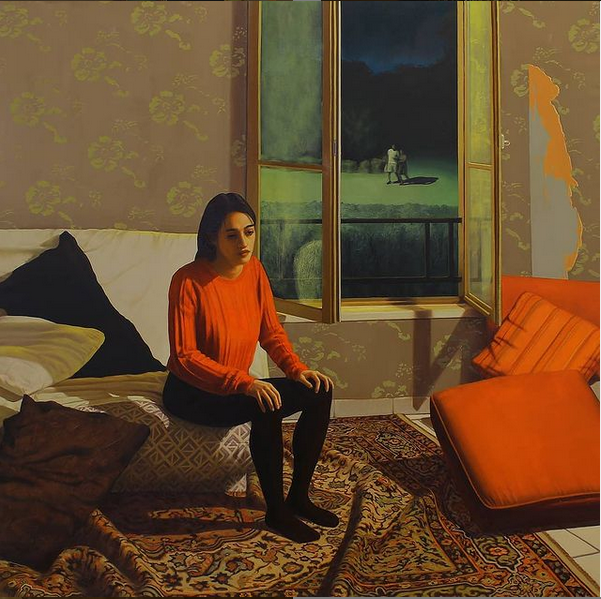
Dhewadi Habjab as a self-aware Hopper

About a painting by the artist placed in majesty in the church of Saint-Eustache
Until 12/12/2021
There is undoubtedly something special about the paintings of Dhewadi Habjab. And it all starts with an immediate and intimate conviction that one has already seen these pictorial works, which are nonetheless new and somewhat singular and strange. Where does this familiarity come from, in the form of an old forgotten connivance? For Amélie Adamo, who devotes two pages to Dhewadi Habjab in this month's L'Œil, there are many points of reference. And they are as much part of the choreographic and cinematographic culture as they are of the pictorial tradition alone. Pina Bausch and Lars von Trier are thus summoned in the same way as Bacon and Borremans. Either.
The reference to Borremans can be understood by the realistic or even hyper-realistic treatment of Dhewadi Habjab's "portraits". It is a reference more technical than artistic. But it is understandable. And Bacon? One could see precisely the opposite: characters exploded in settings of an almost too impeccable rigour. Does this mean that the characters, on the contrary, who are very clean in rooms with systematically torn Habjab wallpaper, mask the Baconian feelings that inhabit them on a cosmetic level? But that they cannot prevent these imperious subterranean impulses from exploding in postures of distorted choreography in these totally out of place places. The references to von Trier and Bausch are easy to understand.

But is this what makes Dhewadi Habjab's painting so good? Amélie Adamo of L'Œil is obviously content with this. Forgive me if I find this attitude slightly light. This tolerance for the easy way out supports the idea that what makes a painter special is a happy assembly of winks to established glories that are plastically in tune with the tastes of the time. Is it enough to express one's love for artists to obtain a sesame to critical recognition? Like: a painter who loves Lars Von Trier can't be a bad guy.
The problem with such an approach to the particularity and therefore the interest of each artist is neither political nor moral. It is simply pictorial. The references proposed by the critic may have been collected from the artist himself. This is not a reason to make them into keys explaining the dance of the brush on Dhewadi Habjab's canvases. For it is certain that one thinks of Pina Bausch when faced with these characters contorting themselves with a dull violence in poses frozen at the limits of the improbable. And it is obvious that Dhewadi Habjab often vibrates internally on the frequencies of Nymphomaniac or Breaking the waves. That's good.
But is this Melancholia-like disillusioned saudade enough to make a work of art artistically interesting on its own? Like: it's a good painting because it evokes great films. Good for you! Should we then praise the less inspired street artists who, by sliding from the wall to the canvas, cover the latter with Mickey Mouse, supposedly in the second degree? What are we to think of such often uneducated and unconscious rehashes of Pop art? Are Dhewadi Habjab's paintings superior to them because of their more noble references? Chic or popular, the wink for the sake of the wink is always so hollow.
But where does this strange feeling come from when faced with these images that are 200% of their time? It's quite simple. This feeling comes straight from the paintings of Edward Hopper. The same sad and frozen solitude of the subjects, but with a whole deployment of motifs, techniques and colours that reinscribe in today's aesthetics, these fragments of eternity of night birds or cinema ushers caught in the reverie of their solitude. Dhewadi Habjab is thus doing a trendy Hopper in the style of 2021. And that is all. With a touch of Balthus to give his choreographies the intriguing air of Saint Vitus' dances. While remaining in our collective imagination.
Illustrations:
- Dhewadi Hadjab - Dream Dancer III
- Dhewadi Hadjab - Contrast - Oil on canvas






































































